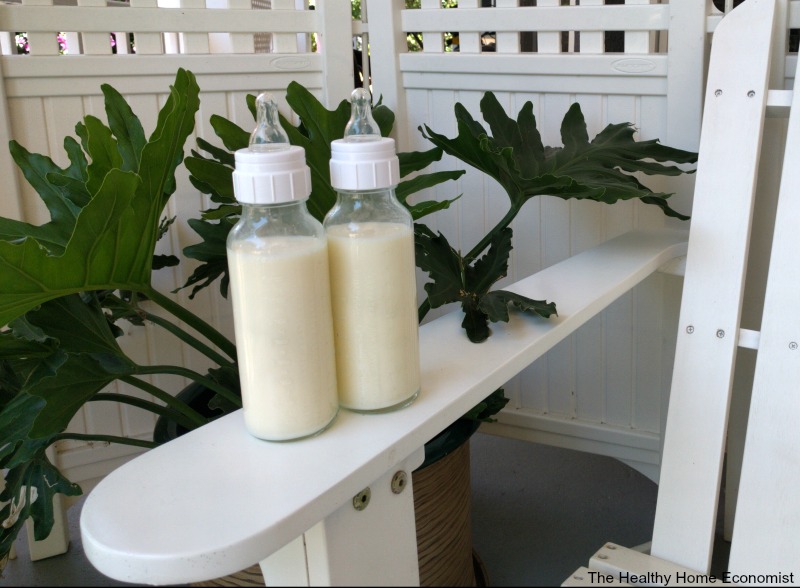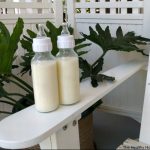Mothers who are unable to breastfeed or procure enough quality donor milk are increasingly making their own homemade formula in lieu of the unhealthy, processed formula powders at the store. Camel milk baby formula is one of the latest trends.

The biggest hurdle to making DIY baby formula, however, is procuring grass-fed raw milk. While the availability of raw cow milk (goat milk and sheep milk too!) continues to rapidly expand around the world, many parents are still not able to buy it where they live. This is where the option for camel milk baby formula comes in.
Camel Milk vs Cow or Goat Milk
Camel milk has suddenly exploded across the globe as one of the most readily available types of raw milk. Milk from camels is a traditional source of dairy for Middle Eastern countries. In fact, it is one of the very first forms of dairy milk that nourished humankind.
Conveniently, it also tastes just like cow milk!
Interestingly, this ease of availability is due to the unique anatomy of camels. It is certainly not an issue of practicality or cost!
There are approximately 18,000 dairy cows in the United States for every camel. And in Europe, the ratio isn’t much more favorable. There are about 12,000 dairy cows for every camel in that part of the world!
The typical camel dairy has between 2 and 20 camels. Each camel produces only about 5.3 quarts/ 5 liters per day! This compares to the several gallons of milk per cow per day that are produced on a typical grass-fed farm.
Camel Milk Availability
Camel milk is certainly not the most practical or affordable type of dairy if you have the luxury of a local farm that supplies it to the community. For some mothers who seek to make a healthy homemade formula for their babies, however, it may be the only option.
I’ve had several mothers email me lately asking if substituting camel milk for cow or goat milk in the homemade baby formula recipe would be acceptable.
Let’s take a look (camel milk baby formula recipe is below too!).
Camel Milk for Homemade Baby Formula
The short answer is most definitely YES! Camel milk is fine to use for homemade formula. The United Nations has even hailed the nutritional value of camel milk and predicted higher consumption once it became easier for consumers to buy.
This “yes” comes with a very important caveat, however.
Camel milk is much lower in fat than cow or goat milk. 50% lower in fact. This is not a trivial difference!
As a result, it is critically important to make sure you add additional cream to the camel milk baby formula. The amount of cream added is included in the recipe instructions below.
This is necessary to ensure that homemade formula made with camel milk nutritionally matches human breastmilk as closely as possible. Not adding additional cream would make camel milk formula too low in fat in comparison with breastmilk.
Can Only Find Pasteurized Camel Milk?
Due to the high demand for camel milk especially for autistic children who seem to thrive on it, you may only be able to find pasteurized. In that case, you will need to make homemade kefir or yogurt with the camel milk. Then, substitute the camel milk kefir for the liquid milk portion of the recipe.
Alternatively, you can buy camel milk kefir as seasonally available.
Be sure to source the rest of the ingredients for the homemade formula from a reputable source. I recommend this one, where every ingredient is vetted for quality.
Camel Cream
Here’s another caveat.
Camel cream (and camel butter) is not available anywhere that I’ve been able to determine. The reason is that it is not feasible to skim the cream from raw camel milk because it is so low in fat. There just isn’t enough cream to make it worthwhile!
So, while you are able to ship raw camel milk to your door, you won’t be able to ship any raw camel cream.
What to do?
In that case, you can use pasteurized cow, goat, or even sheep cream as a substitute.
Why is pasteurized cream acceptable for baby formula and not pasteurized milk?
The reason pasteurized cream is fine and pasteurized milk is not that cream is fat which is resistant to damage from pasteurization compared with the delicate protein portion of milk. Hence, you can use pasteurized cream in the homemade baby formula, but not pasteurized milk.
If you’re having trouble finding pasteurized cream, you can buy low-temp pasteurized (also called “vat pasteurized”), non-homogenized cow milk (“cream top” milk) and suck off the cream with a turkey baster. Pasteurized, non-homogenized milk is widely available in most health food stores across North America that I’ve observed. Perhaps someone from the UK and the EU can chime in about the availability on that continent.
Another option is to buy pasteurized, organic whole milk yogurt (this brand is widely available) and scrape the cream straight off the top with a large spoon. This brand of pasteurized cream is an option as well and ships in the US, Canada, and the UK.
Hopefully, these tips for using raw camel milk properly when making homemade baby formula will help you!
Other Camel Milk Benefits
Camel milk is a wonderful option for making homemade baby formula, and I’m thrilled that Moms now can conveniently ship it right to their door if they are desperate for this healthy option for their babies.
If this choice is something you are considering, note these other benefits for making homemade formula with camel milk:
- Camel milk is high in GABA, a calming amino acid. As a result, you might notice baby more readily naps after a bottle of camel milk formula!
- Camel milk contains over 200 different proteins. This unique profile is different from cow or goat milk. As a result, this particular dairy milk is more easily tolerated for some who might otherwise exhibit an allergy to milk from hoofed animals.

Camel Milk Baby Formula
Homemade formula made using camel milk, one of the least allergenic forms of dairy and one of the first to nourish humankind.
Ingredients
- 2 cups raw camel milk or camel milk kefir
- 1 7/8 cup filtered water
- 1/4 cup liquid whey
- 4 Tbl lactose
- 1/4 tsp bifidobacterium infantis powder
- 4 Tbl raw or pasteurized cream
- 1/2 tsp cod liver oil unflavored
- 1/4 tsp butter oil unflavored
- 1 tsp sunflower oil preferably organic
- 1 tsp extra virgin olive oil preferably organic
- 2 tsp virgin coconut oil preferably organic
- 2 tsp nutritional yeast
- 2 tsp gelatin unflavored
- 1/4 tsp acerola powder
Instructions
-
Fill a 2 cup Pyrex measuring cup with filtered water and remove 2 TBL (this will give you 1 7/8 cup water).
-
Pour about half the water into a pan and turn burner on medium.
-
Add the gelatin and lactose and let dissolve, stirring occasionally.
-
When gelatin and lactose are dissolved, remove the pan from heat and add the rest of the water to cool.
-
Stir in the coconut oil and butter oil until melted.
-
Put remaining ingredients in a glass blender.
-
Add the water mixture and blend for about 3 seconds.
-
Place formula in glass baby bottles or a glass jar and refrigerate.
-
Before giving to baby, warm glass bottle in a pan of hot water or a bottle warmer. NEVER microwave baby bottles!
Recipe Notes
*Do NOT use powdered whey from the store as it is denatured. Do not use whey from making cheese as it will curdle the formula.
*Do not substitute pasteurized or powdered milk as these are heavily processed, denatured and allergenic foods.
*Do NOT use ultrapasteurized (UHT) cream. It is highly allergenic. Raw or pasteurized cream is acceptable.
Collagen powder may be substituted for the gelatin in a pinch (more on peptides in baby formula in this article).
Use only cold-pressed, unrefined, low oleic, organic sunflower oil for this recipe. The brand linked to in the ingredients list is recommended as there many different types of this oil on the market.
If you are wondering where is the iron in homemade baby formula, this article provides an explanation.
If the formula becomes slightly congealed in the refrigerator, it is due to the gelatin. It will re-liquefy when warmed for your baby's next bottle.








Hi, if I can’t get raw milk around me what do I do? Do you know about the price per oz this formula costs? And also is there any way to get whey without making it?